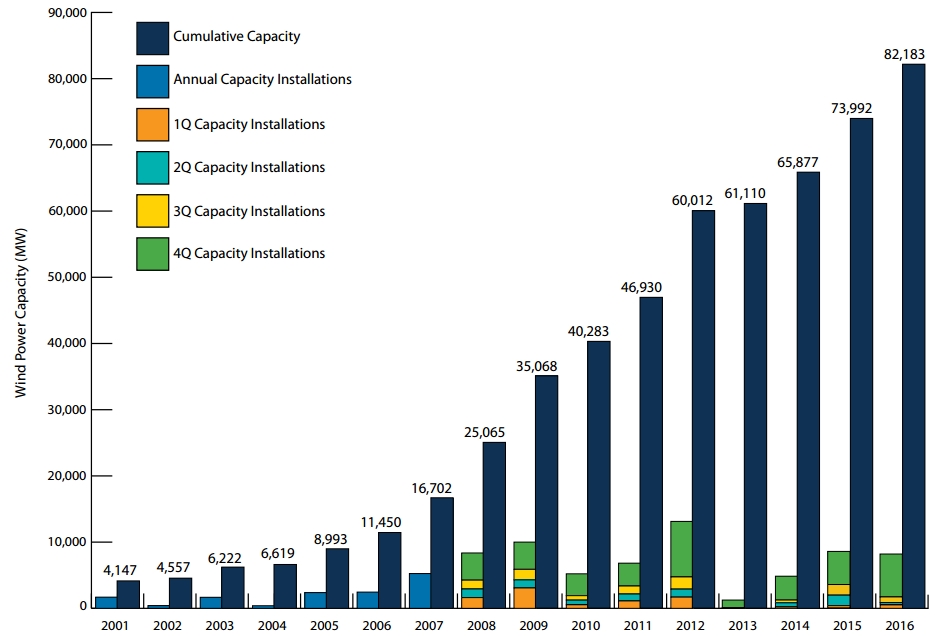Wind: More Perspectives
Bigger and Smaller Picture:
We've talked about payback times and the intermittency of wind as a source of energy. We've looked at some data from California to see how renewable energy sources fit into the bigger picture of energy generation. It feels like the right time to take our discussion to a more national level and think about where we might want to get with renewable energy sources. After that I want to take it down to a more personal level and look at the possible impact of small wind turbines are our homes or in our communities.
Power Needs for US:
It's time to get a little more numerical with the energy use of the US. How much energy is that 100 Quads and what rate do we need to generate it at?

Quads to kWh:
1 Quad is a quadrillion BTU which is a painful unit. Looking at the wiki page we can see that 1 quad = 2.93.1011 kWh. That means 100 quads is 2.93.1013 kWh/yr. To get the rate at which we need to generate power I want kW so I just multiply by my conversion factor..
2.93.1013 kWh/yr x (1 yr/8760 hr) = 3.3.109 kW = 3.3 TW (terawatts)
3.3 TW is the rate at which we currently generate energy in this country. That's a huge number. It gets a little better if you consider that what we actually use is 1/3 of that (roughly 1.1 TW) and 2/3 is rejected energy. Remembering that the capacity factor for wind power is roughly 25% that means if we want to generate ALL of our power with wind we need to install 4.4 TW of nameplate capacity to do the job. Whew -- that's a calculation!
Take Home: The US currently uses power at a rate of 1.1 TW if you ignore the 2.2 TW of 'lost' energy.
How Much Have We Built?
Consider the following plot of installed wind power in the US. Its a couple of years old but checking current data indicates that we are continuing very close to the trend line for this data (2020)

We appear to currently have about 100 GW of nameplate capacity which will yield about 25 GW of usable power. We need 4.4 TW of installed capacity. That means we have 4.3 TW to go. How long will it take us to get there at 10 GW/yr?
4.3 TW/10 GW/yr = 430 yrs
That's an interesting number. Now, if we only want to meet 1/2 our current energy needs with wind power we can get there is 215 yrs at the current rate or 1/4 of the way there in 100 yrs. Hmmm.....
HW: Wind Deeper
This is an exercise in keeping track of proportions. Imagine that we (as a society in the US) manage to reduce our energy needs by half. Imagine also that we triple the rate at which we are building wind farm capacity. How long would you project, in years, it will take for the US to meet half of it's energy needs (the reduced need)?
..the smaller picture:
What if I install wind turbines and try to solve my problems for myself? Since our current needs are about 250 kWh/p/d that would mean we would each need to install 1 MW of wind power (why did I multiply by 4?) to take care of ourselves. That's a really big wind turbine in my backyard and seems a little unlikely. Still, I could put up some smaller wind turbines and at least meet some of my needs. Here's how we do that calculation.
Personal Wind Energy:
The details of this calculation will be on this Sample Wind Calculation page. I have usually done this as a class activity on a worksheet to turn in. In the world of COVID reproducing this calculation for a different month will be a homework problem (below). A copy of the worksheet is here.
HW: Wind Deeper
For this problem you will be doing the same analysis we did in the personal wind energy section. Consider this wind rose for Redmond Oregon in May. Analyze the wind rose and calculate how many hours during May is the wind blowing faster than 5.4 m/s. How many hours during May does the wind blow faster than 8.4 m/s? Using the same power curve for the Aeolos 500W how much energy would you expect to generate when the wind is faster than 5.4 m/s. What is your personal payback time (assuming $0.10/kWh) for this wind turbine if the current cost of a system is $250?
Assignment: HW: Wind Deeper
Complete and assemble your solutions to all the HW problems (2) listed here showing all the steps in your solutions. Scan to a pdf and turn in on LMS. Please review HW format expectations for guidance about your homework solutions.
Reading Ahead:
Next you will read the chapter on Heating/Cooling from David's book before we start the next discussion. This is a quick chapter that lays out more details about where energy disappears around our houses.
